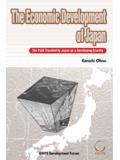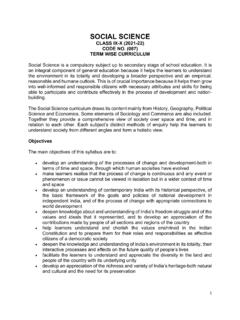Transcription of Cultural heritage protection system in Japan - GRIPS
1 GRIPS Discussion Paper 14-10 Cultural heritage protection system in Japan : current issues and prospects for the future Emiko Kakiuchi July 2014 National Graduate Institute for Policy Studies 7-22-1 Roppongi, Minato-ku, Tokyo, Japan 106-8677 1 Cultural heritage protection system in Japan : current issues and prospects for the future Emiko KAKIUCHI, 1 Professor, Director, Cultural Policy Program, National Graduate Institute for Policy Studies ( GRIPS ) (7-22-1, Roppongi, Minato-ku, Tokyo 106-8677, Japan ) This paper shows how the social importance of heritage in Japan has grown, focusing on the evolution of the protection system .
2 heritage protection has been carried out, largely by the national government, for more than 150 years. Epochal events such as the modernization of the Meiji restoration in 1868 and the democ-ratization at the end of World War II (WWII) in 1945 greatly affected both the designation of the heritage to be protected and the protection system . Rescue of the possessions of the declining aristocracy and temples was the original purpose in the late 1800s, and in the immediate pre-WWII period nationalistic motivations became more important. After WWII, heritage was treated as a national asset, but remained a relatively small part of society for a long time.
3 However the importance of heritage values has recently been in-creasingly recognized and protection measures diversified as Japan has matured in terms of its society and economy. Today heritage is being integrated and linked closely with community development, and its protection is being carried out not only by government but also by various stakeholders. Key Words : Cultural properties, heritage , protection , development, values 1. INTRODUCTION Japan has been modernizing itself for the past 150 years, wiping out the old for the sake of so-cio-economic progress. Since the end of World War II (WWII) in particular, Japan s new constitution renounced war and Japan placed a strong focus on economic development.
4 In many cases, the protec-tion of Cultural heritage was marginalized. However, in recent years, Japan s society and economy have matured, and the national demand for a better quality of life has increased. Demand for non-material satisfaction has led to growing concern about social cohesion, local identity, and culture. On the other hand, due to structural changes in the economy and production, industries have also in-creased attention to the importance of utilizing cul-ture for the creation of economic value. Thus Cultural heritage has been integrated into local communities and has gradually come to be considered an im-portant component of a high-quality life style as well as a precious resource for regional development through Cultural tourism and the creation of high value-added products.
5 Accordingly, the Cultural heritage protection system has evolved to meet these socio-economic changes. The main purpose of this paper is to overview the major achievements of Cultural heritage protection in general, which comprises the core of Japanese cul-tural policy. Also the underlying socio-economic changes will be addressed. Then, current issues and prospects for the future will be 2. Brief history of Cultural heritage protection in Japan (1) Evolution of the heritage protection system in modern Japan (until WWII) heritage has been protected for over a thousand years in Japan . There are several terms referring to the items to be protected in Japan .
6 The present Law for the protection of Cultural Properties refers to them as Cultural Properties, although they were re-ferred to as antiques, national treasures, and spe-cially protected buildings in the past. In this paper, when referring to items specifically protected under the legal system , the words used in the corresponding laws are cited; the word heritage is used when re-ferring to items to be protected in general. Shoso-in, the first museum in Japan , dates back to the 8th century; it is an Imperial storehouse aTodai-ji 2temple and a designated national treasure (included in the World heritage List), which contains many artifacts and books from the Nara era (8th century).
7 It is now managed under the supervision of the Impe-rial Household Agency. Shoso-in is well known as a building with an ancient architectural style utilizing intercrossed triangle logs. Many precious artifacts, buildings, and other valuable items throughout Japan have been protected by stakeholders for a variety of purposes: religious, educational, and social. The modern Meiji govern-ment started to protect heritage for the sake of the entire nation as a part of public policy. Modern Japan started with the 1868 Meiji restoration, when Japan ended several hundred years of national isolation. In order to avoid colonization by western powers, the Meiji government eagerly promoted civilization and enlightenment (which was regarded as synomyous with westernization) to help Japan emerge as a civi-lized military power.
8 Introducing western arts and culture was one of the tools used to attain this na-tional goal, and people lost their interest in pre-modern valuables in general. The Meiji restoration also brought about the de-cline of the previous ruling classes: the families of feudal lords, including the Tokugawas, who had played a major role in the collection and protection of many valuable items. At the same time, the Meiji government introduced an ordinance in 1868 to of-ficially categorize Shinto and Buddhism. Shinto shrines were declared to be the nation s official houses of worship in 1871. This policy led to an anti-Buddhist movement and the neglect of Bud-dhism-related items.
9 Also land owned by Buddhist temples and Shinto shrines, which had been granted in the Edo period (c. 1600 -1868) , was seized by the government under the Confiscation Law (Agechi-rei) in 1871 and 1875. Buddhist temples lost their followers, supporters, and financial base, which led to loss of religious heritage . Collections of the former ruling classes and temples were scattered and lost. Also national land development and rapid in-dustrialization brought about loss of historic sites, places of scenic beauty, and monuments throughout the nation. The following section introduces a series of im-portant measures taken by the government for her-itage protection .
10 A) The first effort: the Proclamation for the protection of Antiques and Old Properties (1871 1897) The Meiji government started heritage protection efforts in 1871 with the enactment of the Proclama-tion for the protection of Antiques and Old Proper-ties. This proclamation was the first law, aimed at conducting surveys and registering and collecting antiques in thirty-one specific categories which in-cluded almost all the present categories of Cultural properties in Japan , except immovable ones. More than 200,000 items were listed under this proclama-tion at that time. This proclamation was revoked in 1897 and replaced by the Ancient Shrines and Tem-ples Preservation Law.



















